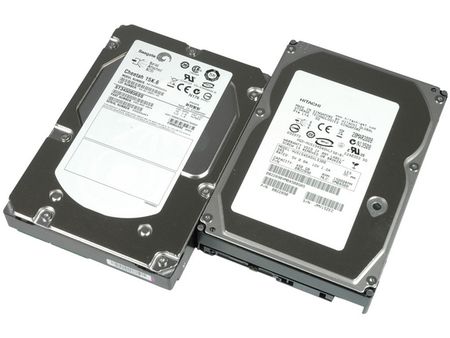SAS Storage: High-Performance Hard Drives
Hitachi and Seagate Spin Up HDD Performance
It’s amazing to see how quickly markets can change. There used to be a rather strict classification among enterprise, desktop and notebook drives, but while the desktop and notebook segments haven’t changed all that much, the enterprise space is undergoing huge changes, due to cost pressure on the one side and the flash memory threat on the other. Hitachi and Seagate have managed to show that modern 3.5” SAS hard drives can still make a pretty convincing argument, though.
SATA for Servers
The advent of Serial ATA moved high-end desktop drives into the enterprise space, because high-capacity SATA drives are powerful enough for near-line storage (that which does not require frequent access) while providing far more capacity than SCSI and SAS drives. Disk archiving and backup solutions are possible applications, and the significant cost savings can be invested into additional spare drives. Hitachi’s Ultrastar A7K1000 and Seagate’s Barracuda ES are examples of this drive breed.
2.5” for Servers
At the same time, a 2.5” form factor doesn’t necessarily imply a notebook drive anymore. In fact, smaller enterprise drives provide better efficiency. We already compared 10,000 RPM and 15,000 RPM 2.5” SAS drives to see how they measure up to their 3.5” brothers, and the result was obvious: 2.5” enterprise drives provide better efficiency and superior I/O performance within the space constraints in rackmount servers.
Flash for I/O
We also looked at flash versus conventional hard drives in RAID array configurations in the article Will SSDs Take Over the Enterprise?. While flash-based SSDs still don’t outperform all enterprise hard drives when it comes to throughput, they beat the hell out of mechanical drives in all I/O-intensive benchmarks. Servers with high I/O loads benefit tremendously from flash-based enterprise storage.
Get Tom's Hardware's best news and in-depth reviews, straight to your inbox.
Hitachi and Seagate to the HDD Rescue
Obviously, the enterprise hard drive market is continuing to shrink, and there will only be a market for drives that combine high performance with high capacity. These will be able to counter flash SSDs in many application scenarios, while providing storage capacity that is more acceptable than the 32 or 64 GB available in the flash SSD product space today.
Hitachi’s Ultrastar 15K450 and the Seagate Cheetah 15K.6 are the latest 3.5” enterprise hard drive models, introducing capacities of up to 450 GB, and 15,000 RPM performance that actually manages to best even the fastest flash SSDs.
Current page: Hitachi and Seagate Spin Up HDD Performance
Next Page Hitachi Ultrastar 15K450